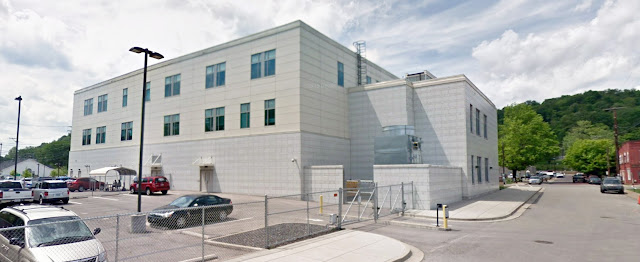 |
An inmate in the Boyd County Detention Center in Catlettsburg, Ky., died of withdrawal symptoms. (Google Maps image) |
America's smallest jails have some of the highest death rates in the nation, spurred by overcrowding and lack of resources, Katie Rose Quandt reports for The Atlantic.
"Across the country, an average of roughly three people died each day in local jails of all sizes in 2016, according to the Bureau of Justice Statistics — a rate that is almost certainly an underestimate. A disproportionate number of those deaths happen in America’s smallest jails," Quandt reports. "Mortality rates were highest in jails holding a daily average of fewer than 50 people between 2000 and 2012, the last period for which BJS reported mortality by jail size; suicide rates were inversely correlated with jail size from 2000 to 2007. Small-to-midsize jails tend to have fewer resources to provide adequate mental-health and medical care, suicide prevention, and drug treatment—services that many people entering jails need. They also often have less oversight and are more overcrowded than their larger counterparts. In many ways, small institutions are the most troubling example of America’s epidemic of preventable deaths in jails—and they are also the least likely to draw public attention."
Jail deaths are almost certainly underreported, not least because many jails routinely release prisoners who are near death, said Jasmine Heiss, director of the Vera Institute of Justice’s "In Our Backyards" initiative, which studies rural incarceration trends.
Recent criminal-justice reforms have led to slow declines in the overall incarcerated population since its 2008 peak, but that's mostly been in state and federal prisons along with large urban jails. "The opposite is true, however, in the rest of the nation’s 3,134 local jails, which are operated by counties or cities and typically hold people who are awaiting trial or serving short sentences," Quandt reports. "Over the same time frame, jail populations shot up 27 percent in rural areas, and 7 percent in small-to-midsize cities."
One reason for rural jail population spikes: even overcrowded jails are increasingly taking in populations from elsewhere to make money. "Roughly 80 percent of jails around the country rented out bed space in 2013 to other counties, federal agencies like the U.S. Marshals Service and U.S. Immigration and Customs Enforcement, or state prison systems. This especially bloats jail populations in rural areas: In 2013, 46 percent of people in rural southern jails were being held for other jurisdictions," Quandt reports. "This trend has completely changed the landscape of local jailing in states like Kentucky. . . . Instead of de-carcerating, the state farms out half its prison population to county jails for $31.34 a day, leaving people serving multiyear sentences in small jails with worse access to programs, services, and health care. . . . Around the country, state departments of corrections limiting their intake during the pandemic have become yet another contributor to growth in jail populations."
Many Kentucky counties seem to be trying to replace coal-related jobs with incarceration jobs, according to Judah Schept, a professor at Eastern Kentucky University who studies rural incarceration. "You have counties becoming reliant on jail infrastructure," he told Quandt. "You have folks who live there anticipating work opportunities at jails and prisons, because coal employment is gone. And you have increasing numbers of people actually going into jail."
"Sometimes, when small counties build massive jails with the intention of housing state and federal detainees, this increased bed space can actually enable more local incarceration," Quandt reports, citing a rural sheriff's quote in a Vera Institute report: "They said, 'If you build it, they will come,' And that’s what happened. The judges knew there was room, so they threw them in jail."
Overcrowding "can mean less programming, fewer services, unsafe conditions, and more time locked down in cells. These problems coincide with other structural difficulties confronting small jails," Quandt reports. That can affect officer retention, the availability of rehabilitative programs, and health-care services.
But jails increasingly serve as first-line resources for mental health, addiction and homelessness in infrastructure-poor rural communities, according to Heiss. "In the absence of broader societal support systems, incarceration has become the catch-all solution in areas hit hard by poverty, unemployment, and the meth and opioid epidemics," she told Quandt.
A Vera Institute data analysis "found that smaller counties are less likely to have resources for programs like pretrial services and diversion programs that keep people out of jail," Quandt reports. "They also use pretrial detention at a higher rate than many jails in bigger cities." About two-thirds of the U.S. jail population is awaiting trial (many because they can't afford bail), compared to 50% before 1993. About 75% of people reported to have died in jail between 2006 and 2016 were awaiting trial.
But pretrial detention doesn't seem to keep the public safer. "A Prison Policy Initiative analysis of bail reforms around the country found that releasing more people before trial does not lead to more crime," Quandt reports. "Pretrial detention does, however, keep people in dangerous and overcrowded jails, instead of allowing them to await trial safely from home."
The story illustrates rural jail disparities with the story of Christopher Hall, a Kentuckian who died in early 2019 from withdrawal symptoms while awaiting trial in the Boyd County Detention Center. Because of previous jail deaths, the county jailer had resigned and the newly elected successor began his tenure just weeks before Hall's death. A corrections expert who analyzed the jail's logbooks said the new jailer had inherited a broken system and hadn't had time to fix the jail's problems. But, Quandt writes, "some structural problems—overcrowding by the courts, an unequal society that often uses incarceration as a solution to mental illness and addiction—cannot be fixed by any one jail or jailer."
No comments:
Post a Comment